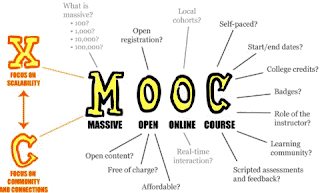CSULA Fall 2018. Reflection Post #13
Differences Among Three Types of MOOC's
cMOOC, xMOOC, and pMOOC
Two decades ago, you you probably would not be able to find anything online about "MOOC's"... times have changed...
The term was coined by Dave Cornier. MOOC stands for Massive Open Online Courses. You can probably guess why the need to coin such a term...yes, the massive online courses are innovative and exciting, although regretfully the course completion rate is very low. Only 2-10 percent of enrollees survive. These are their characteristics: cMOOC is learner role active, instructor role co-learner, learning theory-connectivism, primary pedagogy-knowledge integration, metaphor-"we link movies", development approach-learning design, primary type of assessment-self-assessment, and funding source-seat of the pants funding. xMOOC is learner role-passive, instructor-sage on video stage, learning theory-behaviorism, primary pedagogy-knowledge duplication, metaphor-"we watch movies", development approach-instructional design, primary type of assessment-external and peer assessment, and funding source-large external funding. And pMOOC is learner role active, instructor role -guide on the side, learning theory-constructivism, primary pedagogy-knowledge production, metaphor-"we make movies", development approach-educational design research, primary type of assessment-self-and or client assessment, and funding source-moderate client provided funding. Of all these mentioned, my favorite is pMOOC as the learning theory is constructivism oriented.
http://lizedit4500.blogspot.com

Comments
Post a Comment